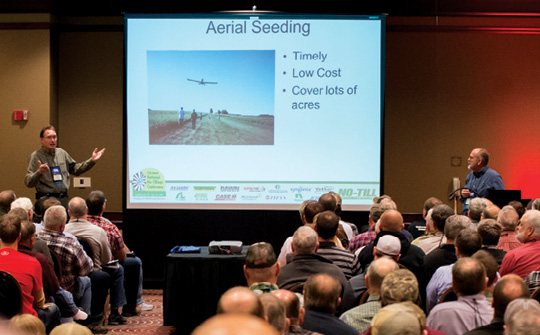Shane and Shawn Tiffany are young, energetic Kansas ranchers, who earned their stripes working for other ranchers before starting their own company in the early 2000s.
Tiffany Cattle Company is small by comparison, but the men have already begun to attract attention for their integrity, attention to detail and innovation.
Next month, Shawn will be a key presenter at the 2019 National Cover Crop Summit, March 20-21, 2019 — a free-to-attend online event featuring a series of seminars by experts across the cover crop spectrum.
It may come as a surprise to some, but the old fashioned feedlot has changed. Ranchers seek pasture grazing to bring healthier diets, as well as lowering their costs for supplemental feed. Shawn’s company raises 32,000 cattle at a time in two locations west of Topeka. They’ve found that cover crops are both sensible and profitable, they also help to rebuild prairie soil depleted from years of tillage and compaction.
In a search of the internet on the subject of cattle and cover crops, there is a surprising diversity in usage throughout the country. Here’s a story from a 1,100 acre ranch/farm in South Dakota, where Jared Namken raises Angus beef. He says rotational grazing allows him to use the entire acreage most of the year, even with heavy snow cover. He says the cattle will dig through the snow to get to the tasty vegetation.
Nancy Peterson and her husband graze cattle on about 4,000 acres of native grasslands in Nebraska, and farm 2,300 acres. They use little to no irrigation and the area is dry; annual precipitation is less than 16 inches.
Getting back to the 2019 National Cover Crop Summit, March 20-21, 2019 , here are some of the other notable presenters:
- Steve Groff, Common mindsets for cover croppers, cover crop consultant, Pennsylvania
- Tom Cotter, Interseeding cover crops for grazing benefits, f
armer, Minnesota
- Paul DeLaune, Extending cover crop benefits in continuous wheat and cotton rotations, Texas A&M Univ.
- Rob Myers, How cover crops impact farm profits, SARE/USDA
- Erin Silva, Rolling cover crops in no-till systems, Univ. of Wisconsin Organic Ag.
- Damon Reabe, Seeding cover crops aerially, even in spring, Cover crop applicator
- Chris Teachout, Alternative row spacing and biomass-building with cover crops, farmer, Iowa







